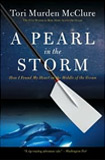Summary | Excerpt | Reading Guide | Reviews | Beyond the Book | Readalikes | Genres & Themes | Author Bio

How I Found My Heart in the Middle of the Ocean
by Tori Murden McClure
In my barge, I would need all the natural assistance I could get. I
closed my eyes and listened to the echoes of thunder. In 49 b.c.e., as
Julius Caesar crossed the Rubicon River with his army on the way to conquer
Rome, he said, "Jacta alea est" (the die is cast). By tomorrow evening,
I will have crossed my Rubicon and there will be no going back.
Each time the thunder and lightning shattered my sleep, I pulled
out the flashlight and checked the compass. It read 45 degrees; the
thunderstorm was blowing the American Pearl toward the northeast.
At its closest point, the Gulf Stream was southeast, but France was
northeast. If every squall blows me toward France, I’ll be praying for
rain. I set the alarm for 5:30 a.m. and went back to sleep.
The next thing I heard was the beep of the alarm. Time to row!
For well over a decade, I’d rolled out of bed before dawn to go rowing,
but this was different. I pulled on my life vest and poked my head
out the main hatch. The smell of salt air filled my nostrils. I clipped
my safety tether into the steel cable that ran the length of the rowing
deck. Then I stood to scan the horizon. The wind tousled my hair.
The sky to the east was just beginning to shift from black to gray. I
searched the southwest horizon, trying to find the light from Bodie
Island. There were no landmarks. There was no land. I’m committed
now; no diving overboard, no swimming back to shore.
I stared into the black water. No rope on board could reach the
bottom. I placed my oars in their oarlocks and screwed the gates
closed. Then I sat down on the rowing seat and slipped my feet into
the shoes that were bolted onto a footplate. Rowers call this plate
a foot-stretcher, but no six-foot-tall woman who wears size-twelve
shoes wants to think about having her feet stretched.
By this time, the eastern sky glistened pink, and I was ready for
my first full day at the oars. Like most rowers, I started at the finish.
That is, I began by sitting in the finish position: legs straight, shoulders
and head high, arms bent, with the oars drawn into my ribs. The
first motion was to send the hands away from the body and out over
the knees. Next, I pivoted from the hips to swing my torso forward.
Once my shoulders were as far forward as I could comfortably reach,
I let my knees bend.
Approaching the catch is like doing a deep knee bend in a seated
position. The sliding seat rolled forward until my torso touched my
knees. At that point I lifted my hands and allowed the oars to drop
and catch the water. Then the process reversed itself. I pushed off the
foot-stretcher, driving my legs down until they were nearly straight.
Then I swung my body open until my shoulders passed over my hips,
and I leaned back until my stomach muscles tightened. Just before
the end of the body swing, I pulled the oars toward my ribs using my
arms. Before the oar handles actually hit my ribs, I pushed my hands
down. This action triggered a seesaw motion of the oars against the
fulcrums of the oarlocks. As the handles went down, the oar blades
went up, rising out of the water. That was one stroke — only one million
and a couple of hundred thousand more to go.
I rowed until 7:00 a.m., then stopped for breakfast. I mixed a
cup of powdered milk and dumped a sandwich bag full of granola
into it. I munched through breakfast in less than seven minutes and
returned to the oars. There were calluses on my hands and on my
backside from years of rowing in flat-water racing boats. I rowed
until noon. By that time, my heels were beginning to blister.
Blisters grow. Blisters break. Broken blisters can become infected. Infections
at sea are bad. Ergo, blisters are bad. I folded myself through the
main hatch. In the cabin, I retrieved the first-aid kit and covered my
heels with a layer of moleskin to reduce the friction and avoid fullblown
blisters. For lunch, I mixed up some powdered Gatorade and
grabbed two food bars.
Excerpted from A Pearl in the Storm by Tori Murden McClure. Copyright © 2009 by Tori Murden McClure. Excerpted by permission of Collins, a division of HarperCollins, Inc. All rights reserved. No part of this excerpt may be reproduced or reprinted without permission in writing from the publisher.
When an old man dies, a library burns to the ground.
Click Here to find out who said this, as well as discovering other famous literary quotes!
Your guide toexceptional books
BookBrowse seeks out and recommends the best in contemporary fiction and nonfiction—books that not only engage and entertain but also deepen our understanding of ourselves and the world around us.